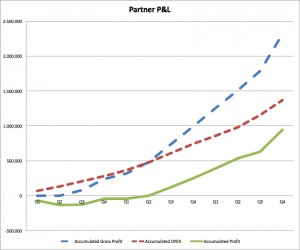P&L issues are the responsibility of CEOs and business unit managers and will require that we speak business management “language.”
Most potential information technology channel partners will initially be attracted to us because of the features and functions that our product provides (most information technology channel partner are product focused). However, the single formula that will help us help our partners become successful is understanding and working actively with “The channel partner Profit & Loss Statement (P&L).”
When discussing a potential cooperation with a new channel partner we use the P&L to relate the investments required for getting started with the the cost and revenue streams that can be expected for the coming 3-5 years.
New business requires investments
Adding a new product to a current business always requires investments (planning, business management, additional staff, training, marketing, pre-sales, sales, facilities etc.), which are returned as customers start buying and using the products and services. If we leave reviewing this investment scenario to our channel partners it is very likely that they will keep the investments at a very low level (maybe at zero) as they primarily focus on the very short term cash flow challenges. We need to lead the discussion and help our channel partners see the long term perspective.
As many of our potential channel partners will be people with a technical background we should be prepared to “educate” them in business model management and in developing the P&L for the cooperation. We may even have to help them find the funding required for getting started, especially in the stage where we ourselves have little proof of concept for our partner based go-to-market approach.
It’s the business model (and not just the product)
P&L issues are the responsibility of CEOs and business unit managers and will require that we speak business management “language.” We must master the entire business model around our product and especially how it works at the partner level. As we share objectives with our potential channel partners, namely building a successful business as fast as possible with as little investment as possible, and as we perform this exercise with new partners all the time, it seems obvious that we must take the initiative and put a draft P&L framework on the table.
The P&L scenario should obviously yield a handsome profit. We must back up the framework with real case stories from other channel partners that already have established profitable businesses with our product. The quality and the empirical validity of our P&L model should obviously improve as we grow our channel and can demonstrate an increasing number of successful partners. However, it is crucial that the channel partner takes ownership of the P&L and does not consider the business model review an exercise required to please us.


